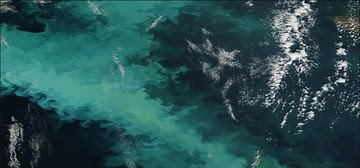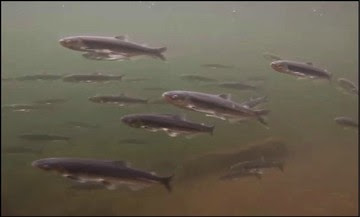HIGHLIGHTS

National Estuaries Week
It’s National Estuaries Week! Estuaries are places where freshwater from rivers and streams mixes with saltwater from the ocean. These transitional areas provide vital habitat for commercial and recreational fish species, shellfish, birds, wildlife—and people.
Estuary Videos
Celebrate National Estuaries Week with us by checking out some of our videos on estuaries, fish habitat, and habitat restoration:
Estuary Story Maps
Virtually explore our habitat restoration work at an estuary near you!
.

Photo: Christin Khan / NEFSC, Permit #17355
New Model Confirms Recent Right Whale Decline
NOAA Fisheries researchers and their colleagues at the New England Aquarium have developed a new model to improve estimates of abundance and population trends of the endangered North Atlantic right whale. Their new method confirms a recent decline in right whale abundance every year since 2010.
Alaska

Image courtesy of NASA Earth Observatory
Exploring the Bering Sea’s Changing Colors
This week, NOAA Fisheries scientists hope to witness the changing colors of the Bering Sea as they investigate why it happens (hint: plankton blooms) and what it means for the ecosystem that supports the nation’s biggest fisheries.
West Coast

Photo: Blane Bellerud / NOAA Fisheries
New Plan Charts Path for Eulachon Recovery
NOAA Fisheries finalized a recovery plan for the southern distinct population segment of eulachon, a small smelt that spawns in coastal rivers like the Columbia River Estuary. Recovery of eulachon would not only benefit the ecosystem, but also restore a resource of enormous cultural significance for tribes and coastal communities.

Photo: Greg Williams / NWFSC
New Puget Sound Species Database Informs Ocean Acidification Research
A new study by NOAA Fisheries scientists has produced a detailed, searchable database of almost 3,000 species found in Puget Sound. The study unravels some earlier assumptions about how vulnerable some species may be to ocean acidification—namely, that whether or not an organism builds a shell may not be the best indicator of their sensitivity.

Groundfish Programs Review – Open for Comment
Following the requirements of its groundfish fishery management plan, the Pacific Fishery Management Council is undertaking a 5-year review of the trawl catch share program (Amendment 20) and intersector allocations (including Amendment 21). Comments on the draft of the catch share program 5-year review are due October 17.
Pacific Islands

Story Map: Hawaiian Island Cetacean Survey
Scientists aboard NOAA ships Oscar Elton Sette and Reuben Lasker are participating in a 187-day Hawaiian Islands Cetacean and Ecosystem Assessment Survey to study whales and dolphins, seabirds, turtles, and habitat around the Hawaiian Islands. They share their sightings in this new story map.

Photo: Courtney Couch, Hawaii Institute of Marine Biology

Photo: Paula Ayotte / NOAA Fisheries
First Collaborative Climate Science Workshop
Staff from NOAA Fisheries, NOAA Satellites, and the Western Pacific Regional Fishery Management Council are meeting this week in Honolulu for the first Annual Collaborative Climate Science Workshop. A component of the Pacific Islands Regional Action Plan for climate science, the workshop aims to identify climate-related management questions for the Pacific Islands and the science needed to address them.
Greater Atlantic

NOAA Fisheries Announces Scup Quota Increase
NOAA announced an increase in the commercial scup quota and possession limit for the period November 1 to December 31. This increase rolls unused quota from January–April into the upcoming season.

Photo: Northeast Observer Program / NOAA
Sector At-Sea Monitor Provider Applications
Companies interested in receiving approval to provide at-sea monitoring services to sectors in fishing year 2018 must submit an application by October 1. Companies already approved to provide at-sea monitoring services for both the 2017 and 2018 fishing years need not reapply to service 2018, and future opportunities will grant approval to provide services over 2-year periods.

Photo Credit: South Atlantic Fishery Management Council
Mid-Atlantic For-Hire Vessel Permitting, Reporting
The Mid-Atlantic Fishery Management Council has received questions about for-hire (party/charter) vessel permitting and reporting requirements. Read more about required Vessel Trip Reports, which must be submitted electronically beginning March 12, 2018.
| 


No comments:
Post a Comment